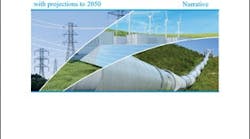Sponsored Content
Annual Energy Outlook 2022 – with projections to 2050
March 7, 2022
Related To:
The Annual Energy Outlook 2022 explores long-term energy trends in the United States
- Projections in the Reference case of our Annual Energy Outlook 2022 (AEO2022) are not predictions of what will happen, but rather, they are modeled projections of what may happen given certain assumptions and methodologies. The Reference case serves as a baseline for comparison between side cases that explain alternative trends. By varying Reference case assumptions and methodologies in side cases, AEO2022 can illustrate important factors in future energy production and use in the United States.
- Energy market projections are uncertain because we cannot foresee with certainty many of the events that shape energy markets—as well as future developments in technologies, demographics, and resources. To illustrate the importance of key assumptions, AEO2022 includes a baseline Reference case and several side cases that systematically vary important underlying assumptions.
- We developed AEO2022 by using the National Energy Modeling System (NEMS), an integrated model that captures interactions of economic changes and energy supply, demand, and prices.
- We publish the AEO2022 to satisfy the Department of Energy Organization Act of 1977, which requires the EIA Administrator to prepare annual reports on trends and projections for energy
use and supply.
What is the AEO2022 Reference case?
- The AEO2022 Reference case represents our assessment of how U.S. and world energy markets would operate through 2050. Our key assumptions in the Reference case provides a baseline for exploring long‐term trends, based on current laws and regulations as of November 2021. The current laws and regulations included in the AEO and a paper addressing the Bipartisan Infrastructure Law are available on the AEO website.
- We based the economic and demographic trends reflected in the Reference case on the current views of leading economic forecasters and demographers. For example, the Reference case projection assumes improvement in known energy production, delivery, and consumption technologies.
- The Reference case serves as the benchmark to compare with alternative policy‐based cases, so in general, it assumes that current laws and regulations that affect the energy sector, including laws that have end dates, remain unchanged throughout the projection period.
Petroleum and natural gas remain the most-consumed sources of energy in the United States through 2050, but renewable energy is the fastest growing
- Motor gasoline remains the most prevalent transportation fuel despite electric vehicles gaining market share
- Energy‐related carbon dioxide (CO2) emissions dip through 2035 before climbing later in the projection years
- Energy consumption increases through 2050 as population and economic growth outweighs efficiency gains
- Electricity continues to be the fastest‐growing energy source in buildings, with renewables and natural gas providing most of the incremental electricity supply
Wind and solar incentives, along with falling technology costs, support robust competition with natural gas for electricity generation, while the shares of coal and nuclear power decrease in the U.S. electricity mix
- Electricity demand grows slowly across the projection period, which increases competition among fuels
- Renewable electricity generation increases more rapidly than overall electricity demand through 2050
- Battery storage complements growth in renewables generation and reduces natural gas‐fired and oil‐fired generation during peak hours
- As coal and nuclear generating capacity retire, new capacity additions come largely from wind and solar technologies
U.S. crude oil production reaches record highs, while natural gas production is increasingly driven by natural gas exports
- S. production of natural gas and petroleum and other liquids rises amid growing demand for exports and industrial uses
- Driven by rising prices, U.S. crude oil production in the Reference case returns to pre‐pandemic levels in 2023 and stabilizes over the long term
- Refinery closures lower domestic crude oil distillation operating capacity, but refinery utilization rates remain flat over the long term
- Consumption of renewable diesel increases as a share of the domestic fuel mix
